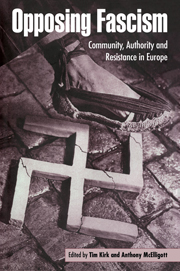Book contents
- Frontmatter
- Contents
- List of contributors
- Preface
- Introduction: Community, authority and resistance to fascism
- 1 The German revolution defeated and fascism deferred: the servicemen's revolt and social democracy at the end of the First World War, 1918–1920
- 2 Dangerous communities and conservative authority: the judiciary, Nazis and rough people, 1932–1933
- 3 The anti-fascist movement in south-east Lancashire, 1933–1940: the divergent experiences of Manchester and Nelson
- 4 Spain 1936. Resistance and revolution: the flaws in the Front
- 5 The Blueshirts in the Irish Free State, 1932–1935: the nature of socialist republican and governmental opposition
- 6 Town councils of the Nord and Pas-de-Calais region: local power, French power, German power
- 7 Structures of authority in the Greek resistance, 1941–1944
- 8 Nazi Austria: the limits of dissent
- 9 ‘Homosexual’ men in Vienna, 1938
- 10 ‘The years of consent’? Popular attitudes and forms of resistance to Fascism in Italy, 1925–1940
- 11 Saints and heroines: rewriting the history of Italian women in the Resistance
- Notes
- Index
10 - ‘The years of consent’? Popular attitudes and forms of resistance to Fascism in Italy, 1925–1940
Published online by Cambridge University Press: 28 July 2009
- Frontmatter
- Contents
- List of contributors
- Preface
- Introduction: Community, authority and resistance to fascism
- 1 The German revolution defeated and fascism deferred: the servicemen's revolt and social democracy at the end of the First World War, 1918–1920
- 2 Dangerous communities and conservative authority: the judiciary, Nazis and rough people, 1932–1933
- 3 The anti-fascist movement in south-east Lancashire, 1933–1940: the divergent experiences of Manchester and Nelson
- 4 Spain 1936. Resistance and revolution: the flaws in the Front
- 5 The Blueshirts in the Irish Free State, 1932–1935: the nature of socialist republican and governmental opposition
- 6 Town councils of the Nord and Pas-de-Calais region: local power, French power, German power
- 7 Structures of authority in the Greek resistance, 1941–1944
- 8 Nazi Austria: the limits of dissent
- 9 ‘Homosexual’ men in Vienna, 1938
- 10 ‘The years of consent’? Popular attitudes and forms of resistance to Fascism in Italy, 1925–1940
- 11 Saints and heroines: rewriting the history of Italian women in the Resistance
- Notes
- Index
Summary
In the fourth volume of his encyclopaedic life-and-times biography of Mussolini, Renzo de Felice caused considerable controversy by arguing for the apparently unlikely proposition that the Italian Fascist regime enjoyed its broadest level of ‘consent’ in the period from 1929 to 1934. It was precisely during the years of the Great Depression, he asserts, that the regime was most popular and stable, attracting wide-ranging support even among the working classes of town and country. This was ‘more extensive and … more totalitarian’ than the enthusiastic, yet shallower and ephemeral ‘consent’ of 1935–6, during and immediately after the invasion of Ethiopia, which is where historians have conventionally located the peakof fascism's popularity.
This interpretation is already a long way from the prevalently anti-Fascist historiography of the 1950s and 1960s, where the only relationship portrayed between the working classes and the regime was one of hostility and antagonism. De Felice was quite deliberately and provocatively challenging what he regarded as the ‘establishment’ left-wing view in his allegedly neutral and value-free history of Mussolini and fascism. He returned to the anatomy of ‘consent’ in the fifth volume of the biography, asserting that widespread discontent was emerging among all social classes and groups in the period between 1936 and 1940, but never at any point became active anti-Fascist opposition.
- Type
- Chapter
- Information
- Opposing FascismCommunity, Authority and Resistance in Europe, pp. 163 - 179Publisher: Cambridge University PressPrint publication year: 1999
- 3
- Cited by



